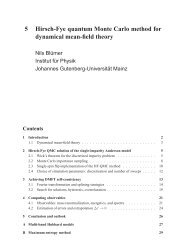Hubbard Model for Asymmetric Ultracold Fermionic ... - KOMET 337
Hubbard Model for Asymmetric Ultracold Fermionic ... - KOMET 337
Hubbard Model for Asymmetric Ultracold Fermionic ... - KOMET 337
You also want an ePaper? Increase the reach of your titles
YUMPU automatically turns print PDFs into web optimized ePapers that Google loves.
Chapter 4<strong>Model</strong> with spin-dependent hoppingIn this chapter we will treat effects arising from spin-dependent hopping in translationallyinvariant systems. The magnetic field is switched off (B = 0) and hopping is spin-dependent(t ↑ ≠ t ↓ ) during this chapter. First we explain our focus on superfluid solutions. We thendiscuss superfluidity in the attractive U model away from half filling with the resulting magnetizationat T = 0 and critical temperatures of the phase transition at half filling. Allnumerical calculations have been done <strong>for</strong> three-dimensional systems.4.1 Charge density wave states and the repulsive modelIn this section we compare the attractive U model (2.1) at B = 0 with its repulsive version athalf filling. We show their equivalence and compose a“dictionary”of corresponding propertiesin order to motivate our focus on superfluid phases in this thesis neglecting possible competingphases, like, e.g., charge density wave phases (CDW).4.1.1 Special particle-hole trans<strong>for</strong>mationHere we present the equivalence of the model (2.1) at attractive interaction and B = 0 withthe repulsive model at half filling in a magnetic field. The proof is done by per<strong>for</strong>ming aspecial particle-hole trans<strong>for</strong>mation:c † i↑→ c † i↑c † i↓→ exp(iQ · i)c i↓(4.1)Q = (π,π,... ,π) T .As was the case <strong>for</strong> the general particle-hole trans<strong>for</strong>mation, studies in (2.56), the specialparticle-hole trans<strong>for</strong>mation (4.1) leaves the hopping-term H t unchanged, but the interactionterm H U changes its sign. The Zeeman-term in the repulsive model is trans<strong>for</strong>med into anadditional chemical potential term in the attractive model. We show the trans<strong>for</strong>mation from35













